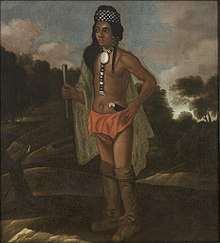Ninigret
| Ninigret | |
|---|---|
 Ninigret in 1681, painting currently at the Rhode Island School of Design Museum | |
| Niantic leader | |
| Personal details | |
| Resting place | "Burying Hill", near Charlestown, Rhode Island |
| Relations | Nephew, Miantonomo |
| Children | Son, Ninigret; daughter |
| Nickname(s) | Juanemo |
Ninigret (also known as Juanemo according to Roger Williams) (c.1610[1]-1677[2]) was a sachem of the eastern Niantic Indian tribe in New England at the time of English colonization. He was based in present-day Rhode Island. In 1637, Ninigret allied with the English colonists and the Narragansetts against the Pequot Indians.
Ninigret is credited with keeping the Niantics out of King Philip's War, in which the English colonists fought fiercely to prevent their homes and settlements from being destroyed by certain Indian tribes.[3]
Biography
Ninigret was the cousin or possibly the uncle of Miantonomo, and his name was written in several ways. He was first known to the English settlers as Janemo and was sachem of the Niantics, a tribe of the Narragansett people. He did not participate in the Pequot war of 1632, and he aided the colonists in the Pequot war of 1637. About a year after the death of Miantonomo, Ninigret formed a plan for expelling the colonists and sent a messenger to Long Island sachem Waiandance to engage him in it. Instead of listening to the messenger, Waiandance tied him up and sent him to the fort at Saybrook. From there, the messenger was transported to Hartford under guard. On their way, the party was forced to put in at Shelter Island, where Ninigret's messenger escaped.[4]
Ninigret passed the winter of 1652-53 among the Dutch in Manhattan and the western Indians. He was suspected of plotting with them against the New England colonists. The commissioners in Boston declared war against him in April 1653, but it was not prosecuted. Meanwhile, Ninigret waged war against the Long Island Indians who had placed themselves under the protection of the colonists. In September 1654, the commissioners sent a message to the chief demanding his appearance in Hartford where they were convened, and also the payment of tribute that had long been due. He refused to appear, and sent them a haughty answer. War was again declared against him, and 270 infantry and 40 horsemen were raised and placed under the command of Major Simon Willard. His instructions were to go to Ninigret's quarters, demand the tribute, and insist upon a cessation of the war with the Long Island Indians. On the approach of the troops, Ninigret fled to a distant swamp and was not pursued.[4]
On October 13, 1660, he and other chiefs mortgaged their territory to the colonists, and he gave them possession at Pettequamscot in 1662. He took no part in King Philip's War (1675-76) and so escaped the ruin that overtook the other tribes. His remains are said to be buried at a place near Charlestown, Rhode Island called Burying Hill.[4]
The Puritans achieved little in trying to convert the Narragansetts or Niantics to Christianity. Roger Williams recorded his discouragement about it. Thomas Mayhew requested Ninigret to allow him to preach to his tribe, and he replied: “Go and make the English good first.”[2][4]
Successors
Ninigret's daughter succeeded him as sachem. At her death, she was succeeded by her half-brother Ninigret, who granted a large portion of his people's lands to the colony of Rhode Island in 1709. This cession of land later created difficulties for the Niantics. The younger Ninigret died about 1722, leaving sons Charles Augustus and George. Charles Augustus died shortly afterward and left an infant son. Some of the tribe acknowledged the boy as their sachem, while another portion adhered to his uncle George, who assumed the entire government in 1735.[4]
George's son Thomas Ninegret became chief in 1746. He sold additional Niantic lands to the colony of Rhode Island which caused discontentment among his people, some of whom tried to depose him. They appealed for relief to Sir William Johnson, the colonial superintendent of the Indians in the Northeast (he was based in upstate New York). They made the case that the Niantic lands which Thomas Ninegret had sold were needed to support the families of men who had died serving the English king in the French and Indian War. In one letter to Johnson, they addressed the question of whether they had the authority to depose a sachem: “As it was in the power of the nation to put him in, we think it in the power of the nation to turn him out.” The controversy continued for several years, but Rhode Island ultimately obtained the lands.[4]
A small remnant of the Niantic people were still living in Rhode Island in 1812.[4] The tribe no longer exists, but some descendants are still among the residents of New England today.
Places named after Ninigret
Ninigret National Wildlife Refuge
- Fort Ninigret
- Ninigret Pond
- Ninigret Park
- Ninigret Beach
Footnotes
- ↑

- 1 2

- ↑ Frederic Denison, Westerly (Rhode Island) and Its Witnesses: For Two Hundred and Fifty Years, 1626-1876: Including Charlestown, Hopkinton, and Richmond Until Their Separate Organization, with the Principal Points of Their Subsequent History, (J.A. & R.A. Reid, Providence: 1878), pg.22 (accessed June 19, 2009)
- 1 2 3 4 5 6 7

Further reading
- Harold M. Chapin, Sachems of the Narragansett. Providence, 1931.
- Julie A. Fisher and David J. Silverman, Ninigret, Sachem of the Niantics and Narragansetts: Diplomacy, War, and the Balance of Power in Seventeenth-Century New England and Indian Country. Ithaca, NY: Cornell University Press, 2014.
- Michael L. Oberg, Uncas, First of the Mohegans. (New York, 2003). Glen LaFantasie, ed., The Correspondence of Roger Williams, 1629–1653, Vol. 1 (Providence, 1988).
- Massachusetts Historical Society, Collections, 2nd Ser. VIII (1826), 59.
- Lafarge, Oliver. (MCMLVI). A Pictorial History of the American Indian Crown Publishers Inc. Page 81.
- Yale University Brief Biography